A detailed look at Leeds and its railways by S P Thompson from The Railway Magazine, July 1915.
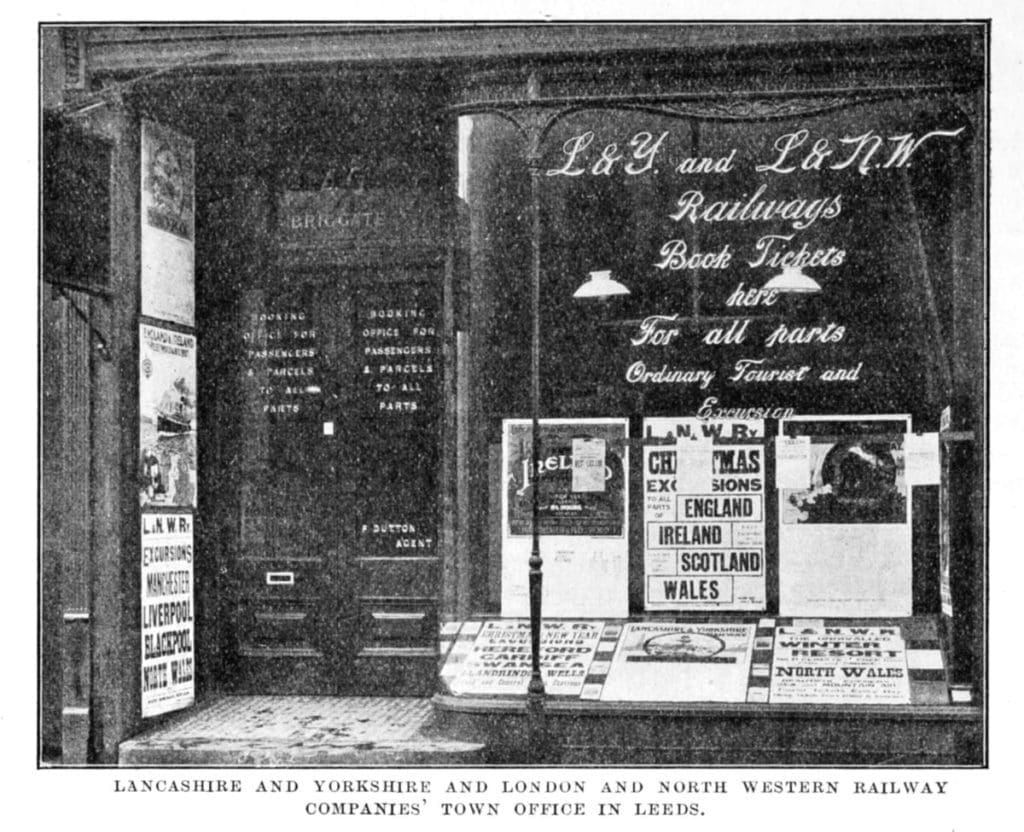
Leeds, the sixth largest city in England, with a population of approximately 500,000 persons, is a most important railway centre. Situated adjacent to the great Yorkshire coalfield, within easy reach of the North and East Riding, and not too remote from the east and west coast ports, it is today the commercial metropolis of the West Riding. Of very ancient growth, it is fitting that the place should have been the scene of early railway development. So long ago as 1759, we learn of a railway or tramway utilised for carrying coals from the Middleton Collieries to Leeds, a distance of some three miles. It was along this tramway that just over one hundred years ago – 1812 to be precise. Blenkinsop’s engine ‘the first commercially successful locomotive used in England,’ hauled a train weighing something like 140 tons, composed of 38 wagons, at the marvelous spread, as it was then considered to be, of three-and-a-half miles an hour. Three similar locomotives were also subsequently constructed in Leeds, and worked on the tramway up to 1830.
Six important railways serve the city, the Great Northern, Lancashire and Yorkshire, London and North Western, Midland and North Eastern Companies. It is true the various goods and passenger stations cannot put forward any considerable claim to architectural beauty, yet they have been laid out on generous lines. The principal passenger stations in the city are three in number. The ‘New’ station houses the North Eastern, London and North Western Companies’ trains; Midland trains run in to the Wellington station adjoining it to the Central station and is the home of the Great Northern, Lancashire and Yorkshire Railways. The Leeds and Selby line, constructed in 1834, was the first railway to convey passengers in the district, and one may be pardoned, therefore, in giving pride of place in any description of Leeds railways to the North Eastern Company, who subsequently took over this branch, more especially as the ‘New’ station in to which company work is the only through station in the city, and also the largest. Powers to erect the station were secured in 1865, and it was opened in April 1867. On January 13th 1892, a disastrous fire destroyed nearly the whole of the west end of the station, and the present complete structure dates from the rebuilding following the conflagration.
Enjoy more Heritage Railway reading in the four-weekly magazine.
Click here to subscribe & save.
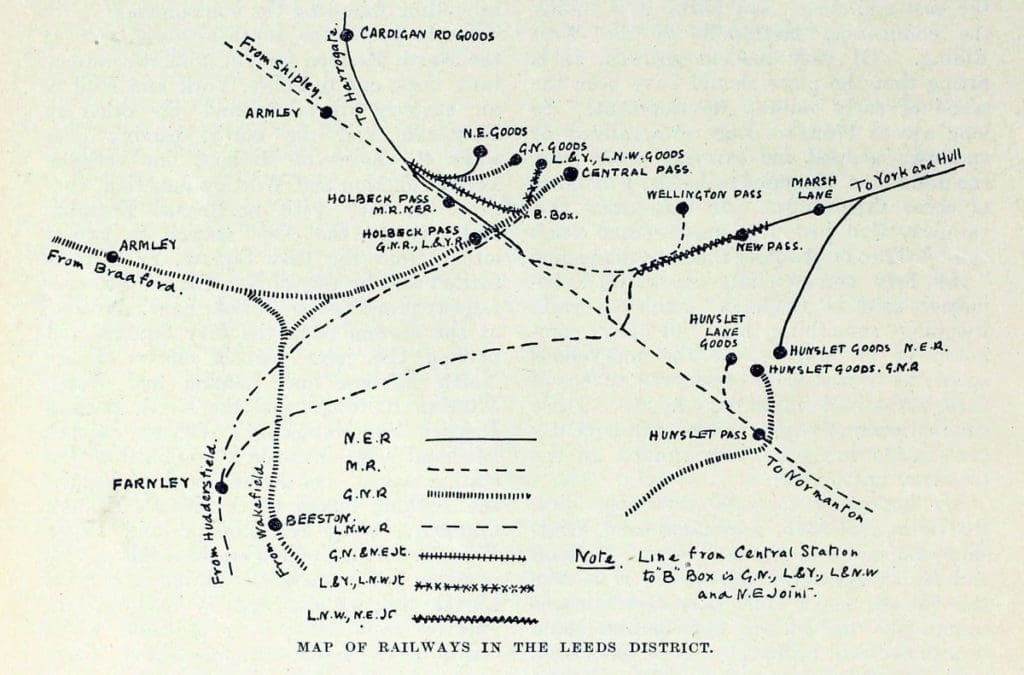
Leeds forms the south-western limit of the North Eastern system, and two important lines, one to Selby, York and Hull in an easterly direction, and the other to Harrogate and the north, passing over some 40 chains of Midland line between Leeds Junction and Wortley Junction, connect the city with north-east England. Entrance to the New station is gained either from the City Square, or a little further east by way of New Station Street – railway property – from Boar Lane. Arriving at the station from the City Square, and passing the joint parcels offices of the North Eastern and London and North Western Railways, and the North Eastern District Superintendent’s Offices on the left-hand side, entrance is obtained to the station proper. On the left-hand are located the booking offices of the North Eastern Company, while the London and North Western booking offices are situated directly opposite. The main circulating area is of liberal proportions, and is well lit; an effective train indicator is provided in the centre for the guidance of passengers. There are ten platforms, of which Nos. 5, 6 and T are “through.” Generally speaking, the North Eastern Railway uses platforms Nos. 5 to 10, and the London and North Western Railway Nos. 1 to 4, though the trains of both systems make use of the through platforms Nos. 5, 6 and 7. The stationmaster’s office is built on the main platform. Various offices for inspectors, telegraph operators and the left-luggage staff are located in the same block as the London and North Western booking offices, ie.. on the right-hand side of the main entrance. The block of buildings of which of which the North Eastern booking offices for a part also contains waiting rooms for ladies and gentleman. The refreshment and dining rooms are well—equipped and attract a considerable number of travellers. They front on to the main circulating area and platforms Nos. 2 and 3. The island platforms Nos. 6 and 7 are reached by means of a wide footbridge and incline from No. 5 platform. There is considerable geographical distribution of traffic at the station: trains for and from certain districts are dealt with regularly at one platform. This arrangement is, however, at times departed from to meet the exigencies of traffic. The New station is managed by a Joint Committee of the two owning companies, known as the Leeds New Station Joint Committee.
The principal long-distance services maintained to and from the city by the North Eastern Railway are (1) with Newcastle, Edinburgh and Glasgow, via York; and (2) with Newcastle and Edinburgh, via Harrogate, over what is termed the “Leeds Northern line,” which was amalgamated with the North Eastern Railway in 1854. The chief trains in these services are the 8.55 am. Leeds to Glasgow; the 5 pm. from Glasgow (Queen Street) to Leeds; and the 9.40 am. train Leeds to Edinburgh, via Harrogate. The 8.55 am. express, via York, covers the 230 miles to Edinburgh in 4 hours 37 min., with stops at York and Newcastle; the 80 miles 11 chains between the two latter points are traversed in 89 min. The train, which is composed of up-to-date electrically-lit stock, vestibuled throughout with breakfast and luncheon car accommodation, is to-day the quickest by any route from Leeds to the Scottish capital. In the winter months, through coaches, detached at York, are conveyed by this train for Scarborough; during the summertime these become unnecessary, as a through train from Leeds to the “Queen of Watering Places” departs immediately in the wake of the “Newcastle flier.”
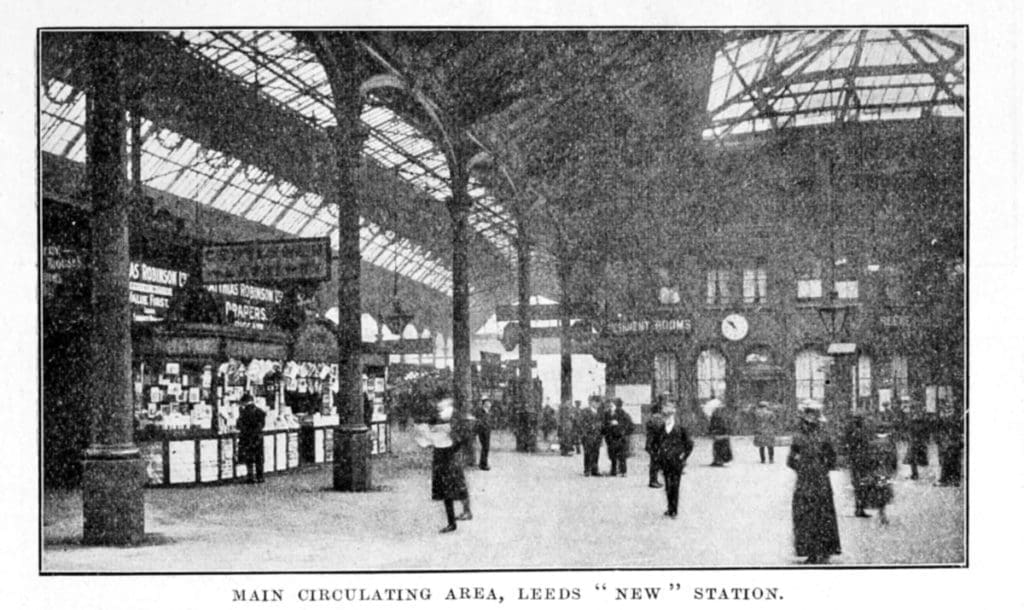
Important through services with other lines, via Leeds, New station, are (1) with Newcastle and Liverpool, London and North Western Railway; (2) Hull, Paragon station, and Liverpool, London and North Western Railway; (3) Scarborough with Manchester and Liverpool, London and North Western Railway; and (4) a through train between Scarborough and Bradford, Midland – non-stop Scarborough-Leeds and vice versa – each way. The two latter services are summer ones only.
The North Eastern Company possess the heaviest residential traffic of any railway serving Leeds. Harrogate and York, the Yorkshire coast watering places, and the smaller country towns and villages within a few miles of the city claim a very considerable number of regular passengers. In dealing with this “rush” traffic, the Company have, in the case of some of the shorter journeys, successfully employed steam auto-cars consisting of an engine with a passenger coach at either end for the conveyance of passengers between home and business, and vice versa; these give a quick service to and fro, and obviate the necessity for reversing operations at destination stations.
The Company’s locomotive sheds and carriage sidings are situated at Neville Hill, some 1 1/2 miles east of Leeds New station, and at busy times there is something approaching a continuous stream of rolling stock passing between the two places. An interesting feature in connection with the staff arrangements at the station is the provision of railway servants’ coffee rooms, where railwaymen may obtain refreshment at a reasonable price. The building stands at the entrance to platform No. 1.
Railways serving Leeds cater for a very extensive excursion and holiday traffic, and in normal times the excursion, week-end, ten-day and tourist bookings to North Eastern resorts are often very heavy. Many thousands of passengers are booked to Bridlington, Scarborough, Whitby, Saltburn and other resorts, and at such times the New station presents a most animated scene. The North. Eastern own an attractive publicity office in Commercial Street, the fashionable shopping centre of the city, where information relative to holiday resorts, train services and the like is furnished and tickets issued.

London and North Western principal passenger train services with the city are those to and from Manchester, Liverpool and North and South Wales. This Company’s trains are also housed in the New station. The bookings to Llandudno and other popular Welsh coast holiday resorts are considerable during the season; this traffic has doubtless felt the benefit of the extensive North Wales publicity campaign which the Company have conducted.
An interesting phase of the traffic dealt with at the station in normal times is the frequent running of emigrant specials from Hull, North Eastern Railway, to Liverpool, London and North Western Railway, by way of Leeds. The heavy train loads of Continental emigrants on route to America formed a picture not likely to be soon erased from the mind. One can imagine the officials would heave a sigh of relief as the tail lamps of these trains, with their cosmopolitan freight, disappeared over the London and North Western metals in the distance.
“Wellington” (Midland) passenger terminus adjoins the New station, with which it is connected by a covered approach. It is of the closed type. Six platforms are provided, and as it is situated on the Midland main line, an excellent service of trains connects the city with the principal English and Scottish centres. There is also a considerable holiday traffic with Morecambe, Heysham (for Ireland and the Isle of Man), the English Lake District, and the south and west of England during the season. A number of the Lancashire and Yorkshire Railway Company’s trains from Doncaster run into this station giving connections from Goole, etc. The district offices of the Company are located in the City Square – quite near to the station – and Messrs. Thos. Cook & Sons, passenger agents for the railway, own an attractive office in Boar Lane. Adjacent to the Midland station, and fronting on to the City Square, is located that Company’s “Queen’s Hotel,” one of the most popular hotels in the city, and a recognised meeting place for commercial men.
Central station, which houses the Great Northern and Lancashire and Yorkshire Companies’ trains, is situated in Wellington Street, about 400 yards distant from the other principal passenger stations, and is reached from the street either by way of a road running between the Great Northern Company’s palatial hotel and the station at the east end, or by a staircase at its western extremity. The seven platforms, which are “closed,” are, generally speaking, made use of by the trains of both Companies. Separate booking offices are provided for the issue of tickets to stations on the respective railways.
The Great Northern Railway route from Leeds to London is the shortest and quickest available, and the service is very popular with West Riding commercial men having business in the metropolis. All the principal trains as also those on the Midland route between Leeds and London, include restaurant cars. The quickest time for the run is provided by an up journey of 3 hours 25 min. for the 1853 miles. In Doncaster race week many hundreds of followers of “the sport of kings” make their way to the “butter-scotch town” by the Great Northern route.
Lancashire and Yorkshire principal services are with Manchester, Liverpool, Southport and Blackpool, and the more important trains on this route are composed of up-to-date corridor stock with lavatory and refreshment car accommodation. At holiday times the ordinary trains for Blackpool are well filled, and in addition a considerable excursion traffic is catered for. The workers of the West Riding find in “Blackpool’s bracing breezes” a splendid tonic. In the summer months through express trains are run to and from the Lincolnshire coast watering places (Skegness, Mablethorpe and Sutton-on-Sea), and to those on the Norfolk coast (Sheringham, Cromer, Yarmouth, etc.). Local services are given to Bradford (by express trains in 17 min.), Wakefield, Batley, Dewsbury, Morley, Gildersome, etc.
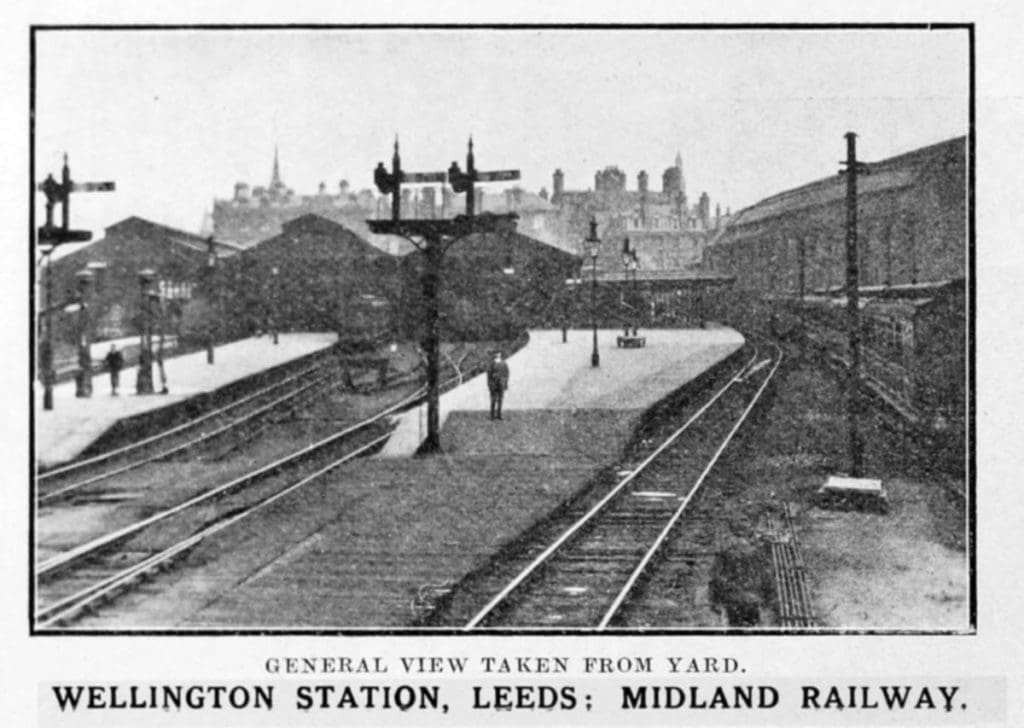
The Lancashire and Yorkshire and London and North Western Railways have a joint office at 140, Briggate, Leeds, which is extensively used for the issuing of tickets, dealing with parcels traffic and enquiry purposes. The principal industries of the City of Leeds are iron and steel making, ironfounding, engineering, locomotive and wagon building, printing, woollen and‘ worsted manufactures, tanning, boot and shoe making and chemical manufactures. The leading railway goods depots are the North Eastern Railways VVellington Street and Marsh Lane stations; the Wellington Street and Hunslet depots of the Great Northern Railway; the stations of the London and North Western, and Lancashire and Yorkshire Companies in Wellington Street; and the Midland Company’s Hunslet Lane depot‘.
There is heavy North Eastern traffic with north-east England, the east coast ports and Scotland. In addition to general merchandise, the Company handles large consignments of live stock. The offices of the District Goods Manager and District Goods Agent adjoin the Wellington Street goods station. The goods warehouses here have been designed with a view to enabling traffic to be loaded and unloaded with a minimum of handling, and the lay-out of the sidings has also been conducted with a View to efficient working. It is interesting to note that a heavier tonnage of agricultural machinery and engines is forwarded from the station than from any other place on the North Eastern system. Approximately 4,000 tons of this particular traffic are dispatched annually. Adjacent to the goods warehouses are situated the Company’s grain and flour stores. Large quantities of these commodities are stocked.
Marsh Lane goods depot (North Eastern Railway), at the other side of the city, east of the New station, also accounts for a very considerable tonnage of traffic. From this station an express goods service connects the city with Edinburgh, Glasgow and other Scotch centres. The Company also own goods stations at Cardigan Road and Hunslet, within the city boundary, and work to many sidings and works in the city. Among the latter may be mentioned the Leeds Forge Company’s works, and the Monk Bridge Iron works. There is a very considerable exchange of traffic wit-h the Great Northern, London and North Western and Midland Railways to and from the North Eastern system. Shipment goods to Hull, Middlesbrough, Hartlepool and the Tyne ports form no mean proportion of the North Eastern outward traffic dealt with at their stations. From these ports there are steamship services to practically all parts of the world.
The Great Northern Railway goods station is located about 200 yards east of the North Eastern depot, and also fronts on to Wellington Street. The district goods and passenger offices of the railway are situated on the opposite side of Wellington Street to the passenger station. Large consignments of traffic to and from London and the principal centres of population served by the railway pass through the depot, and various sidings linked up to the railway in and around Leeds help to swell the tonnage. Extensive storage accommodation under cover is available. The Hunslet depot is most conveniently situated in the City for traffic to and from the market.
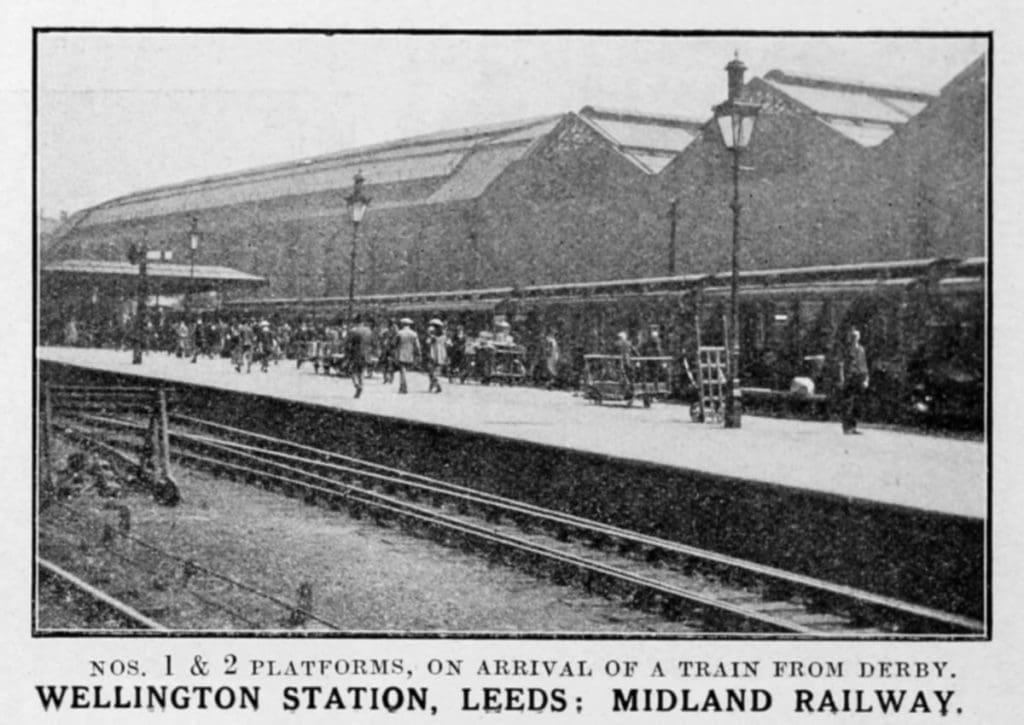
Adjacent to the Great Northern Railway goods station is situated the Lancashire and Yorkshire and London and North Western Companies’ goods depot and grain and Excise Bonding warehouse. The offices of the two railways are located in one block of buildings in Wellington Street, close to the goods station. The two lines have an extensive business both inward and outward in wagon-load traffic and smaller consignments, and in addition to their ordinary rail forwardings, dispatch considerable quantities of merchandise to Ireland by their steamers from the west coast. They also deal with a very considerable shipping traffic for and from Liverpool, Manchester, Fleetwood, and the Humber.
To reach the Midland Railway depot, one must make quite a considerable journey from the other goods stations, for it is situated in Hunslet Lane, half-a-mile southeast of the Wellington Street stations. The traffic conditions here are not markedly different from those existing at the other Leeds goods stations.
Merchandise is received from and dispatched to all parts of the kingdom, and the warehouse and storage accommodation is extensive. The Company also tap several of the more important works in and around the city by means of siding connections, and in addition deal with a heavy carted traffic.
Advert
 Enjoy more Heritage Railway reading in the four-weekly magazine. Click here to subscribe.
Enjoy more Heritage Railway reading in the four-weekly magazine. Click here to subscribe.




